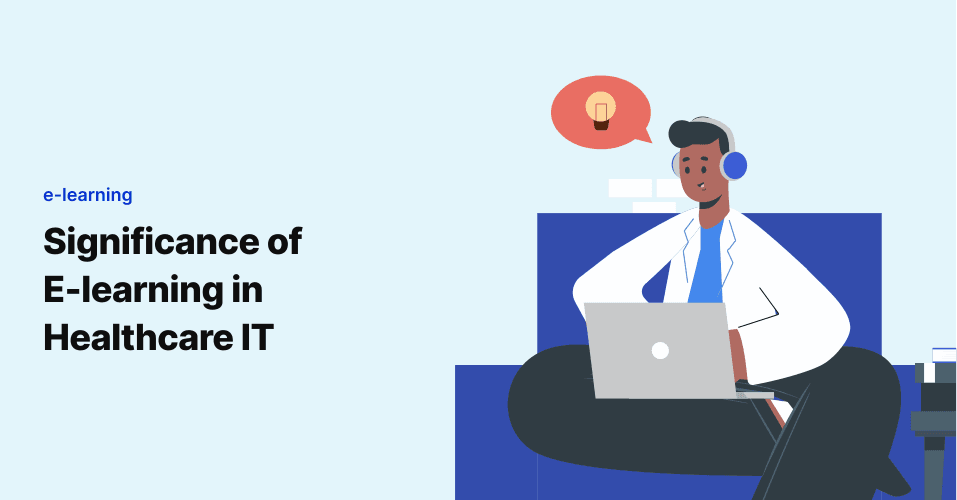
3 Common Mistakes in Epic Training
Hospital project teams that are tasked with implementing Epic EHR have no shortage of important steps to …

The implementation of an EHR is certainly a breakthrough for your health system; however, clinicians are still not satisfied. Ever wondered why?
Your health system has an EHR to improve the quality of care through patient data sharing. Efforts are being taken to optimize EHR to improve its use. However, there’s something that is being missed out when it comes to optimization efforts.
Most health systems somehow fall back on optimizing learning that could help clinicians cope with software changes. New features and functionality make clinicians very uncomfortable; they remain confused and struggle to navigate this. The prime cause for this is the lack of learning resources that provides them with the required knowledge to use the EHR features optimally in their workflow.
While there are many ways to do this, this article specifically looks at how ongoing EHR support could help with your EHR optimization.
Ongoing EHR support is specifically chosen here because it helps you keep your users adequately prepared to get the best out of the EHRs at present and even in the long run.
In this article, you will learn about:
If you still haven't thought about EHR optimization, then it is important for you to know that an EHR that isn't optimized can increase your clinician's EHR documentation difficulties and be a key contributor to clinician burnout. A recent research by KLAS shows that burnout and EHR dissatisfaction are two key factors for clinician turnover. This is just one side of the coin. The other side to this is that difficulties due to the lack of EHR optimization contribute to an increase in documentation errors which is a severe threat to patient care and safety.
Clinicians aren’t able to combat the difficulties for the reason that they do not find solutions to help them in times of need. One of the best ways to optimize your EHR and simplify usability is by providing ongoing EHR support. The continuous support would help them quickly accomplish their workflow tasks while improving the quality of work. It could be a key component of your EHR optimization efforts because it directly impacts the clinicians’ interaction with the interface. This is crucial because it reduces the pain of getting things done and ensures that the clinicians are in the right direction to accomplish a specific goal in the EHR.
Before diving into the benefits of ongoing EHR support, it's essential to recognize that optimization starts with a strong foundation. Without a structured training approach, even the best support systems can only do so much. If you want to ensure your clinicians have a solid starting point, check out How to Approach Epic Software Training and Succeed.
Now, providing ongoing EHR support could be helpful in the following ways:
When clinicians are continually provided guidance on how to accomplish something, the initial fear is driven away, and they are able to use the EHR better. In fact, the awareness that there will be support provided at each step of accomplishing something in the workflow would make them want to start using the available features on the EHR to make their job easy.
Clinicians are mainly frustrated with EHRs because they find it difficult to accomplish things quickly and easily without requiring additional effort. The best way to help them is by supporting them throughout the process of working with EHRs so that it no longer seems to be a burden.
The idea of having support whenever you need it is in itself a motivation to use the EHR without worrying. Most clinicians are reluctant to effectively use an EHR because they worry that it would just make things difficult for them. The reason for having ongoing EHR support is to instill confidence in them to go about their workflow without having to stress about anything else.
When provided with the right ongoing EHR support, your clinicians would be able to perform tasks on the EHR the right way, and this would ensure improved care coordination throughout the health system.
There are various ways to provide ongoing EHR support to your users, and they are:
Help desks are quite a popular means to provide ongoing EHR support. When using help desks, healthcare organizations usually hire a support team with whom the clinicians can get connected for any workflow difficulties. The clinicians are required to raise support tickets for anything related to their workflow, and the support team goes through the various support tickets raised and resolves them in a systematic manner.
With the help desks, there is every chance that there might be a delay in supporting clinicians as the resolution is a long multi-step process, and there are interdependencies involved in support.
At-the-elbow support is one way to provide ongoing EHR support in which an expert is available at the elbow of clinicians whenever they require a solution to meet workflow needs.
This is an extremely personal way of providing support; however, it is also a very costly method, and the number of queries that can be resolved is fairly less.
This is one of the most common ways that your clinicians can use to receive support when it comes to working on EHRs. Social learning simply means that clinicians learn about the most efficient workflow by asking their peers whenever they face an issue.
The downside to social learning is that it could become a serious problem when the peer provides guidance without being absolutely sure of the suggested solution.
A Just-in-time (JIT) support tool helps clinicians access ongoing EHR support without taking anyone’s help. It improves end-user performance by providing “just-in-time” assistance in the workflow through self-help resources. Neither does this tool require an additional team to support, nor does it cause a delay in waiting for the solution to be provided. In addition to this, it also guarantees a standardized solution to an efficient workflow through centralized resources.
One of the easiest ways to optimize your EHR and improve the user experience is to use a JIT tool like Jeeves for ongoing EHR support. This is possible mainly because, when you compare JIT to other kinds of support, it helps you achieve efficiency much quicker at relatively lesser costs.
The most powerful way to provide ongoing EHR support and improve user experience would be as follows:
The most effective way to deal with and improve something is to make corrections right when problems arise. The earlier the problems are fixed, the quicker one gets to accomplishing the goal. The same goes for discovering the path to the most efficient EHR workflow. To make this possible, the healthcare organization is required to continually support its EHR users, especially when they need it the most.
If users are provided with support that is specifically tailored to their workflow, it becomes extremely easy for them to comprehend a piece of the solution and retain it in the long run. This helps them better use the EHR and improves their efficiency.
There is a relatively lesser problem until change enters the picture. Your users would get comfortable when they are continually supported for everything in the current EHR interface. However, when there is an upgrade, confusion kicks in, mainly because things change. This could be the best time to take help from your internal experts and have them create support content resources that could be put into your JIT support tool for users to access. By this, you can eliminate the need for an external team and provide support by keeping your users at the center of focus. This is made possible because your internal experts would be super users who best understand user problems and changing requirements.
Yet another important aspect to keep in mind while considering ongoing EHR support for EHR optimization is continually improving the support provided. The best way to do this is to get your user feedback on how satisfied they are with the support provided.
When all of this is followed and done right, your clinicians in no time will start using the EHR the right way. This could be great for the health system not only because the investment made in the EHR would be fruitful but also because the clinicians would be using the EHR in the most impactful way, which would result in improved patient care.
Join over 3,200 subscribers and keep up-to-date with the latest innovations & best practices in Healthcare IT.

Hospital project teams that are tasked with implementing Epic EHR have no shortage of important steps to …

The LMS, or Learning Management System, is one of the go-to solutions for training in many hospitals. Its …

Short and sweet. That’s the focus of today’s discussion around e-learning for Healthcare IT, and it’s an …